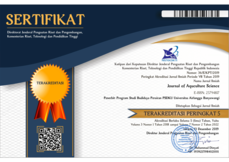Application of Bioflocs Combined with Probiotics for Prevention of Vibrio Parahaemolyticus Infection In White Shrimp (Litopenaeus vannamei)
Downloads
Shrimp farming with intensive system was causing many problems. The presence of disease problems in shrimp caused by bacteria, viruses, or co-infection was a problem that must be solved. The use of probiotics and biofloc was one way to overcome the existing diseases. In addition, the combination was expected to improve the performance of the shrimp immune system. This study aimed to evaluate the using of biofloc combined with probiotics against vannamei (Litopenaeus vannamei) immune system in the challenge test with V. parahaemolyticus. This research was conducted for 5 months. The treatments were the addition of commercial probiotics in the culture medium with biofloc system on the feed in the form of negative control (without probiotics + without biofloc) (1), positive control (biofloc culture medium and without probiotic adduction) (2), probiotics I + bioflok (3 ), probiotics II + biofloc (4), and probiotics III + bioflok (5). The results obtained for the performance performance of the shrimp immune system that the best in treatment 4 (probiotic II + biofloc) with SR yield of 76.67%, THC of 9.7 x 106 ml-1, and total bacterial count of 1.59 x 107.
Keywords: Vannamei, Probiotics, Biofloc, Immune System.
Ai Q, Xu H, Mai K, Xu W, Wang J, Zhang W. 2011. Effects of dietary supplementation of Bacillus subtilis and fructooligosaccharide on growth performance, survival, non-specific immune response and disease resistance of juvenile large yellow croaker, Larimichthys crocea. Aquaculture, 317: 155-161.
Aly SM, Mohamed MF, John G. 2008. Effect of probiotics on the survival, growth and challenge infection in Tilapia nilotica (Oreochromis niloticus). Aquaculture Research, 39:647-656.
Avnimelech Y. 1999. Carbon/nitrogen ratio as a control element in aquaculture system. Aquaculture, 176: 227-235.
Blaxhall, Daishley KW. 1973. Routine Hematological Methods for Use with Fish Blood. Journal Fish Biology 5: 577-581.
De Schryver P, Carb R, Derfoirth P, Boon N, Verstrete W. 2008. The basics of bio-flocs technology: The added value for aquaculture. Aquaculture, 277: 125–137.
De Schryver P, Derfoirth P, Sorgeloos. 2014. Early mortality syndrome outbreaks: a microbial management issue in shrimp farming. PLOS Pathog., 10(4): e1003919
Flegel, TW. 2012. Historic emergence, impact and current status of shrimp pathogens in Asia, J. Invertebr. Pathol. 110(2) 166-173
Hauton, C. 2012. The scope of the crustacean immune system for disease control. Journal of Invertebrate Pathology, 110(2), 251–260.
Hsieh, S. L., Ruan, Y. H., Li, Y. C., Hsieh, P. S., Hu, C. H., & Kuo, C. M. (2008). Immune and physiological responses in Pacific white shrimp (Penaeus vannamei) to Vibrio alginolyticus. Aquaculture, 275(1–4), 335–341.
Li, J., Tan, B., & Mai, K. 2009. Dietary probiotic Bacillus OJ and isomaltooligosaccharides influence the intestine microbial populations, immune responses and resistance to white spot syndrome virus in shrimp (Litopenaeus vannamei). Aquaculture, 291(1–2), 35–40.
Khatoon, H., Banerjee, S., Guan Yuan, G. T., Haris, N., Ikhwanuddin, M., Ambak, M. A., & Endut, A. 2016. Biofloc as a potential natural feed for shrimp post larvae. International Biodeterioration and Biodegradation, 113, 304–309.
Lomelí-Ortega CO., Sergio F. Martínez-Díaz. 2014. Phage therapy against Vibrio parahaemolyticus infection in the whiteleg shrimp (Litopenaeus vannamei) larvae, Aquaculture 434 208-211
Nayak SK. 2010. Probiotics and Immunity: A Fish Perspective. Review. Fish and Shellfish Immunologi, 29: 2-14.
Qin, Z., Babu, V. S., Wan, Q., Zhou, M., Liang, R., Muhammad, A., Lin, L. 2018. Transcriptome analysis of Pacific white shrimp (Litopenaeus vannamei) challenged by Vibrio parahaemolyticus reveals unique immune-related genes. Fish and Shellfish Immunology, 77, 164–174.
Raja R Ananda, R Sridhar, C Balachandran, A Palanisammi, S Ramesh, K Nagarajan. 2107. Pathogenicity profile of Vibrio parahaemolyticus in farmed Pacific white shrimp, Penaeus vannamei, Fish. Shellfish Immunol. 67: 368-381.
Smith, V. J., Brown, J. H., & Hauton, C. 2003. Immunostimulation in crustaceans: Does it really protect against infection? Fish and Shellfish Immunology, 15(1), 71–90.
Teixeira-Lopes MA, Vieira-Girí£o PRN, da Cruz Freire JE, Rocha íRCB, Costa FHF, Rádis-Baptista G. 2011. Natural Co-infection With Infectious Hypodermal and Hematopoietic Necrosis Virus and Infectious Myonecrosis Virus in Litopenaeus vannamei in Brazil. Aquaculture, 312: 212-216.
Verschuere L, Rombaut G, Sorgeloos P, Verstraete W. 2000. Probiotic Bacteria as Biological Control Agents in Aquaculture. Microbiology and Molecular Biology Reviews, 64(4): 655-671.
Wang YB. 2007. Effect of Probiotics on Growth Performance and Digestive Enzyme Activity of The Shrimp Penaeus vannamei. Aquaculture, 269: 259-264.
Watson AK, Kaspar H, Lategan MJ, Gibson L. 2008. Probiotics in aquaculture: The need, principles and mechanisms of action and screening processes. Aquaculture, 274: 1-14.
Widanarni, Sukenda, Setiawati M. 2008. Bakteri Probiotik dalam Budidaya Udang: Seleksi, Mekanisme Aksi, Karakterisasi dan Aplikasinya Sebagai Agen Biokontrol. Jurnal Ilmu Pertanian Indonesia, 13 (2): 80-89.



















